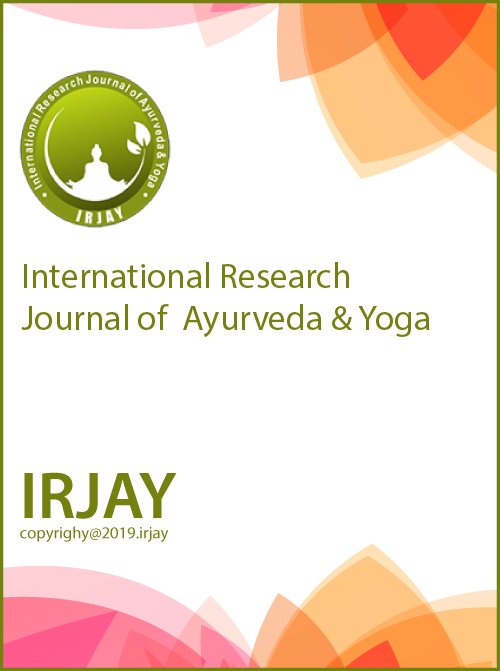Developing Topical Gel Formulation of Erandakarkati (Carica papaya Linn.) Latex for Managing Indralupta: A Preliminary Study
DOI:
https://doi.org/10.48165/IRJAY.2025.80401Keywords:
Ayurveda topical gel, Carica papaya latex, Carica papaya, Erandakarkati, IndraluptaAbstract
Introduction: Indralupta, a tridosha-raktaja vyadhi, is marked by patchy hair loss caused by blocked hair follicles due to aggravated Rakta and Kapha doshas. This blockage disrupts nutrient flow to the follicles, resulting in hair fall and bald patches. Ayurveda recommends dietary changes, oral medications, and Panchakarma therapies for restoring dosha balance. Carica papaya (Erandakarkati) is known for its medicinal properties, especially in its latex, which contains enzymes like papain and chymopapain with anti-inflammatory and antioxidant effects. Methods: This pilot study aimed to evaluate the efficacy of a topical C. papaya latex gel for treating Indralupta. Thirteen participants aged 20–60 years were selected from the outpatient department of Dravyaguna at Vaidyaratnam Ayurveda College. A pre-post interventional design was used, assessing subjective and objective parameters at baseline, and on the 7th, 14th, 21st, and 28th days. The gel was prepared using Carbopol 934 and triethanolamine and applied daily for 10 min over 28 days. Safety was ensured through a patch test on healthy volunteers. Results: By the end of the 28-day treatment, nine participants showed no hair fall, and eleven exhibited hair growth in previously bald areas. However, the bald patch size did not significantly change. No participants reported itching, and the gel was confirmed safe by the patch test. Demographic analysis showed that most participants were male, married, educated, and middle-class, with a preference for non-vegetarian diets and spicy foods. The onset of Indralupta was mostly sudden. Discussion: The C. papaya latex gel showed promise in reducing hair fall and promoting hair regrowth in Indralupta patients over a 28-day period. However, the lack of significant change in bald patch size suggests the need for longer treatment or additional interventions. The small sample size and short treatment duration limit the generalizability of the results. Conclusion: C. papaya latex gel may be effective in treating Indralupta, but further research with larger sample sizes and longer treatment durations is needed to validate these findings.
Downloads
References
1. Juárez-Rendón KJ, Rivera Sánchez G, Reyes-López MÁ, García-Ortiz JE, Bocanegra García V, Guardiola-Ávila I, Altamirano-García ML. Alopecia areata. Current situation and perspectives. Arch Argent Pediatr. 2017;115(6):e404-11. doi: 10.5546/aap.2017.eng.e404
2. Paradara HS. Ashtanga hrudaya with sarvangasundara commentary of arunadatta and ayurvedarasayana commentary of hemadri. 9th ed. Varanasi: Chaukambha Orientalia; 2005. p. 859.
3. Acharya JT. Susrutha samhita with nibandhasangraha commentary of dalhana. Varanasi, India: Chaukambha Sanskrit Sansthan; 2009. p. 709.
4. Aryavaidya Sala Kottakkal. Indian Medicinal Plants. Vol. 1. Hyderabad: Orient Longman Publishers; 1996. p. 383-4. 5. Mayer W, Weibel M, De Luca C, Ibragimova G, Trakhtman I, Kharaeva Z, Chandler, DL, Korkina L. Biomolecules of fermented tropical fruits and fermenting microbes as regulators of human hair loss, hair quality, and scalp microbiota. Biomolecules. 2023;13(4):699. doi: 10.3390/biom13040699
6. Gurung S, Skalko-Basnet N. Wound healing properties of carica papaya latex: In vivo evaluation in mice burn model. J Ethnopharmacol. 2009;121(2):338-341. doi: 10.1016/j.jep.2008.10.030
7. Bruno-Moreno F, Sombra Basílio De Oliveira R, De Azevedo Moreira R, De Azevedo Moreira R, Pinto Lobo MD, Teixeira De Freitas CD, Viana Ramos M, Barbosa Grangeiro T, Oliveira Monteiro-Moreira AC. Crystallization and X-ray diffraction analysis of an antifungal laticifer protein. Acta Crystallogr Sect F Struct Biol Cryst Commun. 2013;69(Pt 6):646-9. doi: 10.1107/S1744309113016427
8. Haedon DJ, Overbeek PA. Involvement of a novel TNF receptor homologue in hair follicle induction. Nat Genet. 1999;22:370-4. 9. Krause K, Foitzik K. Biology of the hair follicle: The basics. Semin Cutan Med Surg. 2006;25:2-10.
10. Sperling LC. Hair anatomy for the clinician. J Am Acad Dermatol. 1991;25:1-17.
11. Saitoh M, Uzuka M, Sakamoto M. Human hair cycle. J Invest Dermatol. 1991;54:65-81.
12. Srivastava AK, Srivastava SC, Srivastava N. Hair disorders, treatment, and care: An overview. J Eng Appl Sci. 2015;29:1-16. 13. Singhal P, Vyas V, Chhayani P, Patel M, Gupta SN. Ayurvedic
management of alopecia areata: A case report. J Ayurveda Integr Med. 2022;13(3):100604. doi: 10.1016/j.jaim.2022.100604 14. Srikanthamurthy KR, Astanga Sangraha of Vaghbata, by K.R. Srikanthamurthy. 2nd ed. Varanasi: Chowkhambha Orientalia; 1999. 15. Govindas K. Bhaisajya Ratnavali. Hindi Commentary by Prof. Siddinananda Mishra. 1st ed. Varanasi: Chaukhamba Surbharati Prakashana; 2005.

